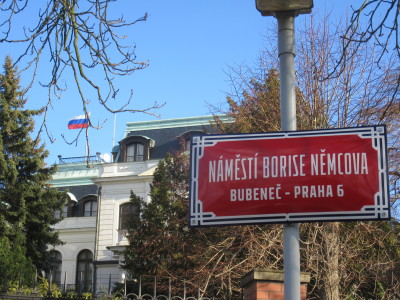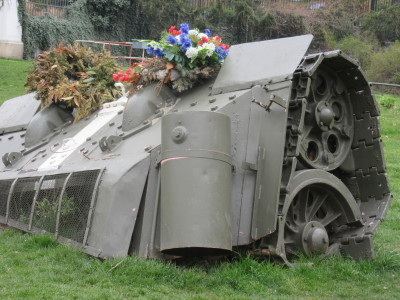The COVID-19 crisis was used quickly and efficiently – now that there was no need for protests, he was disposed of: General Konev, Marshal of the Soviet Union. Not himself, of course, but his monument in the Prague district Bubeneč. Since then, there has been great disagreement between the Czech Republic and Vladimir Putin’s Russia.
But the dismantling of the monument is only one of a long series of targeted provocations directed at the Kremlin, with which people in the Czech Republic are protesting against Vladimir Putin’s neo-Stalinist history policy and for an appropriate remembrance of the victims of communism.
Since 1980, he stood in bronze on a pedestal in Prague: Ivan Stepanovich Konev. His Red Army soldiers had marched into Prague on May 9.
Among the communists, May 9 was, therefore, celebrated as the day of liberation from the Nazi occupation. This picture had always been a little crooked, because in reality the German occupiers had already capitulated to the military leaders of the Prague uprising the day before.
Mainly supported by bourgeois resistance forces, the uprising, which had begun on May 5, was intended to drive the Nazis out and equally prevent the Communists from taking full control of the city. Only since the Velvet Revolution of 1989 has May 8 been celebrated as the official day of liberation.
Since then, more and more people have been thinking about Konev. He had helped in the suppression of Hungary in 1956 and presumably also in the military plans to suppress the Prague Spring in 1968. And people were really reluctant to remember that.
Throwing Paint Bags as a National Sport
Time and again – most recently in 2015 and 2016 – there have been debates in the Prague City Council Bubeneč about whether the monument should be dismantled. Every time, mercy was shown.
However, the price paid by the council was high: throwing paint bags at the marshal has become a popular sport, so that enormous cleaning costs were associated with the maintenance of the monument.

Nemzow-Square with Russian Embassy and Flag ©Friedrich-Naumann-Stiftung für die Freiheit
When the Council finally decided to dismantle the monument in October 2019, it knew that this would cause diplomatic trouble. That is why they hesitated at first to implement the decision.
The Russian government and its embassy in Prague also immediately sounded the alarm that fascism was now on the advance in the Czech Republic – an accusation that outraged the mayor, Ondřej Kolář, who comes from the ranks of the civil rights-based TOP09 party.
In addition, as argued in Russia, the dismantling goes against international treaties for the protection of war memorials and will entail criminal consequences for the causers, although this applies actually only to war graves and not to the glorification of disputed Soviet marshals.
The Prague mayor’s suggestion (possibly meant to be conciliatory) that the statue should simply be placed in the garden of the Russian embassy in the same district, was rejected by the Russians as cynical. On April 3, therefore, the decision to dismantle the statue was carried out – virtually under the cover of the Corona crisis.
Which brings us to the subject of the embassy: on February 27, 2020, the 5th anniversary of the assassination of the Russian opposition politician and civil rights activist Boris Nemtsov, the council approved a petition signed by countless citizens to rename the square in front of the Russian embassy “Boris Nemtsov Square”.
Many observers assumed after the murder of Nemtsov that the Russian government was involved in the crime. To make matters worse for the Russian government, the capital city of Prague and mayor Zdeněk Hřib also publicly agreed to the renaming.
Since the Russian government always maintained its innocence, the Russian ambassador was invited to the inauguration of the new street sign, but this did nothing to calm the waves. As expected, the ambassador did not attend the ceremony.
A Suitcase Full of Poison?
In the meantime there are even death threats against Mayor Kolář and Lord Mayor Hřib, which are credited to Russian backers in the media. A well-known weekly magazine reported on a Russian agent who had already come to Prague three weeks ago with a small suitcase full of poison bottles. The story sounds outrageous, but the two local politicians are now under strict police protection.
Since the Czech Republic is less willing to make an appeasement to Putin than parts of the German public, other mayors in the district were also prepared to take an offensive stance. Only two months after the decision on the Konew monument, the Czech city government of the district Řeporyje, led by the conservative Civic Democrats, voted in favour of the erection of a new monument to commemorate the events of May 1945.
This was to be dedicated to the soldiers of the so-called Vlasov army. The Vlasov soldiers were Russian military forces who had broken with Stalin’s rule in 1944 and sided with Hitler. Towards the end of the war they again fell away from Hitler and supported the Prague Uprising of May 5, 1945. 3
00 of them fell in the fight for the democratic forces in occupied Czechoslovakia.
As historians, one may take a differentiated view of the Vlasov army, but as a political symbol, the decision to erect a monument to temporary Nazi collaborators was probably not a happy one, to say the least. The disagreement between the Czech Republic and Russia, where the Vlasov soldiers are regarded as traitors to the fatherland, has thus been dramatically exacerbated.
Also Řeporyjes’ Mayor Pavel Novotný is now under police protection.
Guerilla Actions
The scepticism towards Russian superpowerism that has prevailed in the Czech Republic since the suppression of the Prague Spring has led to an almost popular inclination towards such guerrilla actions “from below”. They sometimes put official foreign policy in uncomfortable situations, but they also cannot be prevented.

Cerny’s buried invasion tank from 1968 ©Friedrich-Naumann-Stiftung für die Freiheit
They began back in 1991, when the last Soviet troops left the country. They left behind a memorial on which a large Soviet tank was placed, which is said to have been there when the troops moved in on May 9, 1945. In a night action at that time the sculptor and action artist David Černý painted the tank pink. The authorities reacted without humor and had the tank restored to its original condition. There were threats of punishment and in the end even a short-term arrest of the artist.
Finally, a group of 15 parliamentarians used their immunity and painted the tank pink again in broad daylight as a gesture of solidarity. So it happened that the tank changed color several more times. The parliament finally deleted the status of the monument as a national monument (worthy of protection).
In the end the – pink! – tank was moved to the Military Museum Lešany, about 20 kilometres south of Prague.
In 2018, on the 50th anniversary of the suppression of the Prague Spring in 1968, Černý – a kind of Robin Hood in an artist’s garb – placed the fragment of a tank that had participated in the invasion at the time, half buried in the same square in the Smíchov district. Again, there were protests from the Russian embassy.
This time, however, the city government did not allow itself to be dissuaded and subsequently granted permission for the unconventional monument, which still stands there today.
Anti-Totalitarian Memory Policy
One thing is certain: Communism and the occupation of 1968 have left their mark on a still very vivid culture of remembrance in the Czech Republic. People like to recall that the country was the only functioning democracy to emerge after the First World War, and that this experiment in democracy was ended twice from the outside – first by the Nazis in 1939 and then by the Soviet-controlled Communists in 1948.
In contrast to the historical-political debate in Germany, the concept of totalitarianism also plays an important role. It is about the comparability of National Socialism and Communism due to the structural characteristics of tyranny in the sense of a total subjugation of society in the service of an ideology.
But while large parts of the Czech public acknowledge that German policy clearly distances itself from the injustice of the Nazi occupation, the ice age is upon Russia. Putin’s politics of history are too clearly working towards the rehabilitation of Stalin.
Time and again, even on the part of Russian representations and lobbies in Prague, there are small but hurtful pinpricks, in which the injustice of the Soviet occupation is relativised or even glossed over.
In 2014, for example, the cemetery administration of the Russian military cemetery had to remove a new monument that veterans of the Afghanistan war living in Prague had erected. On it was a bilingual plaque in Czech dedicated to the memory of Russian soldiers who died during peace missions.
The only catch was that the Russian text did not refer to peace missions but to “internationalists and peacemakers”, which was the trivialising term used by the Soviets to describe the invading troops when the Prague Spring was crushed in 1968. Protests raged and the plaque had to disappear.
Also the war graves for the Red Army were ostentatiously covered with Russian flags on May 9 (and not on Czech Liberation Day, May 8). Most Czechs do not consider all this to be a confidence-building measure. The Russian side basically regards the Red Army’s activities in the country as a series of acts of liberation.
Side Entrance on the Business Card
And how does the Czech Republic’s “grand policy” deal with the rebelliousness of the people of Prague towards Russia and Putin’s policy? In a resolution, the Czech Senate, the second chamber of parliament, condemned Russia’s criticism of the Konev dismantling as an “attack on national sovereignty” and, alluding to the death threats, recalled that Russian agents have often murdered disagreeable critics in other countries (think of the case of Sergei Skripal in 2018).
In the face of such harsh tones, Foreign Minister Tomáš Petříček then struck a marginally milder note. The Council’s decision on the Konev monument is legally unassailable and must be accepted, he said, but they will help to transport the statue safely to Moscow, if they want to put it up there. The hardness of the matter, but kindness in tone smoothed the waves a little.
Czech Prime Minister Andrej Babiš also emphasized that Russia must accept the decision to dismantle the statue and that it would have to accept any interference from the Russian side, but that it would also work against any escalation.
Deputy Prime Minister Karel Havlíček explained that they are waiting for the Czech secret service to analyze how serious the threat to Czech mayors really is. Only then will they consider measures such as the expulsion of Russian diplomats.
In addition, the Russian ambassador has found a face-saving solution to the problem that his official address on his business card is now “Boris Nemtsov Square”.
Without further ado, a side entrance to another street has been declared the official main entrance of the embassy – thus avoiding the embarrassing reminder of the alleged actions of the Russian government at least on the ambassador’s business card.
The article was originally published at: https://fnf-europe.org/2020/05/12/ice-age-between-the-czech-republic-and-russia/
Continue exploring:
Statue of Soviet Marshal Versus City of Prague: Kremlin Strikes Back



